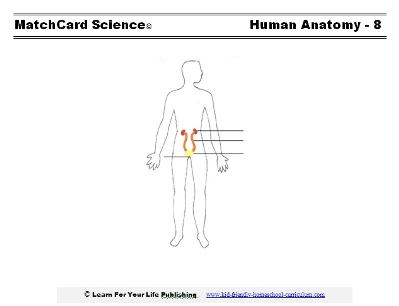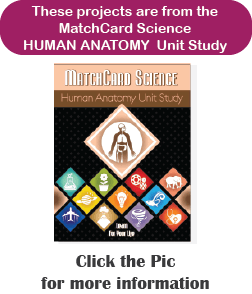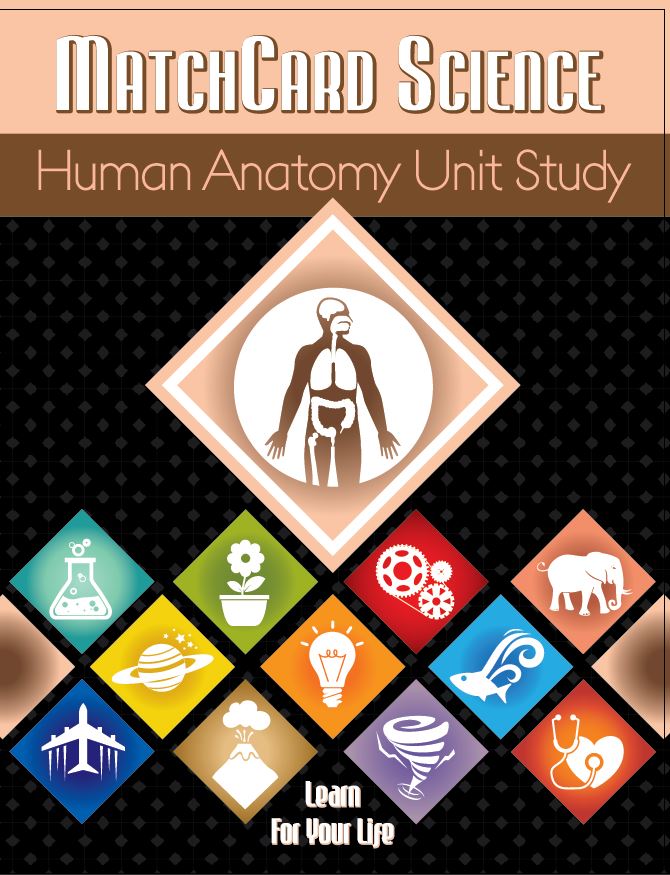Human Organ Systems
Renal System: Kidneys and Bladder
This Kidney and Bladder MatchCard is one of the human organ systems in the Human Anatomy Unit Study for grades 3 - 8.
Free Download Below


MatchCard Science Kidneys and Bladder Worksheet
Objective: Describe the functions of the major parts of the renal system.MatchCard Information Pieces identify and describe the kidneys, ureters, bladder and urethra. Ideas for projects are listed on the instructor's page and below.
Download the Kidney and Bladder MatchCard
This is MatchCard #8 of the Human Anatomy Unit Study.The 1st page is the students' worksheet. The first page has human organi systems diagrammed in color..
The 2nd page is in black and white. Students may color the organs different colors.
The 3rd page is the Instructor's Guide with the correct answers.
The 4th page has the Information Pieces. Student's cut them apart and place them in the correct place on their copy of the Matchcard (first page.)
For more information on how to use the Matchcards, see the MatchCard Science Instructor's Guide.
The Kidneys
The renal system is one of the most important human organ systems. The kidneys filter waste products from the blood stream and secrete them as urine.Where Are Your Kidneys?
Place your hands on your hips with your thumb pointing to the back and your fingers resting on your abdomen. Now slide your hands up until you find your rib cage.Slide your hands up and down until your fingers are resting at the very bottom of the rib cage. Then hold them still.
Your thumbs are over your kidneys.
Size and Shape of Kidneys
Your kidneys are the same shape as a kidney bean. Hmmm, where do you think the kidney bean got its name, anyway?A kidney is somewhat crescent shaped - like a quarter moon that is full of fluid. It really is an interesting and unique shape.
Your kidney is about 2/3 the size of your hand.
- On a piece of paper mark the height and width of your hand.
- Use a ruler to mark off 2/3 the height and 2/3 the width.
- Can you now make a model of a kidney the correct size and shape?
Project: The Kidney as a Filter
For this project you will need:- A coffee filter (or thick paper towel)
- A pitcher of water
- A clear glass or bowl
- Dirt
- Add dirt to the water to make it dark and dirty. Don't put in so much dirt that you make mud.
- Put the filter over the glass or bowl.
- Slowly pour the dirty water onto the filter so it drips through.
- Watch as cleaner water is filtered through the paper.
- You may want to repeat it using the cleaner water. Pour it through another filter and see if it gets cleaner.
The kidneys filter the blood the same as the coffee filter cleaned the water. Larger particles of waste are separated from the fluid since they can't go through the small holes in the filter.
More Kidney Facts for Kids
- An average adult has 5 to 6 liters of blood in his or her body. (How many two liter soda bottles is that?)
- All that blood is filtered by the kidneys every three to five minutes.
- You have two kidneys. You can live with only one kidney. But if the second one stops working, the person will die within a day or two.
- Kidneys make urine. The urine contains some of the fluid and all of the waste products that were filtered through the kidney.
- Kidneys can be transplanted so people with kidney failure can live a normal life.
- Kidneys do other important things for us:
- Regulate the amount of water in the blood
- Keep our blood pressure normal
- Help make red blood cells to carry oxygen from our lungs to the cells
- Balance the pH of our blood.
- Regulate the amount of water in the blood
3 Other Parts of the Renal System

Ureters
The ureters are two tubes that carry the urine to the bladder. There is one ureter attached to each kidney.The urine is drained by gravity down the ureter.
Bladder
The bladder is a muscular pouch low in the pelvis. Urine is constantly being made by the kidneys and sent drip by drip down the ureter.Don't you hate to think what life would be like if you didn't have a bladder to hold the urine?
Once the bladder is full, the brain sends a message to the person that they need to urinate. Let's hope there's not a long line at the bathroom.
Urethra
The urethra is the tube that takes the urine from the bladder to the outside of the body. When a person urinates the bladder contracts (or squeezes). The urethra relaxes and lets the urine flow out.Experiment: Timing the Renal System
How Long Does It Take to Run Through
Some fluids are diuretics. That means they make the kidneys work faster, and hence you void faster (void is the nice way to see "pee").Here is an experiment that you can do to time how fast it takes for fluid to go in and then out.
- Don't drink any fluid until after you have urinated in the morning. That will empty out all the waste the kidneys filtered over night.
- Measure two cups of water and drink it. Write down the time, and don't drink anything else.
- Time what time you need to void again.
That was pretty lame. We are going to take it up a notch with some known diuretics.
- Repeat the instructions above, but drink two cups of cola or coffee in the morning. Ask permission first if you usually do not have these beverages in the AM.
- Time how long until nature calls.
- Any difference?
- Mocha
- Decaffeinated Tea
- Milk
- Orange Juice
- Power Drinks
Hmmm, sounds like you could have fun in the name of advancing science. A hypothesis could be developed to make this a bonafide science fair experiment - but I don't think you really want to go there, do you?
The Other Human Organ Systems
MatchCard Science has 12 human organ systems. These include:MatchCard Science
How To Use MatchCards

Download the FREE MatchCard Science Instructor's Guide and see how MatchCards can make building their science knowledge base fun.
Human Anatomy Unit Study

Download the entire Human Anatomy Unit Study
12 Science Unit Studies

Chemistry is only one of twelve complete unit studies for kids in 3rd to 8th grade.
Comprehensive objectives, hands-on projects, suggested science fair experiments, and the fun game-like MatchCards keep them interested in learning science. See all twelve MatchCard Science Unit Studies.
About Our Site
Hands-On Learning














